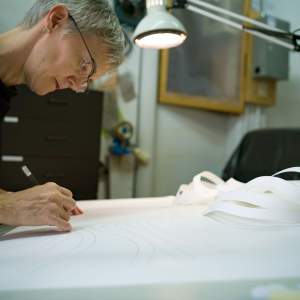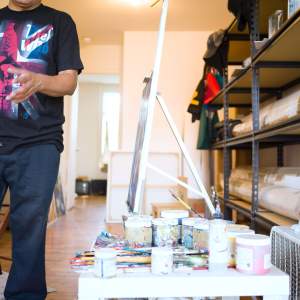Rose Candela is an artist, teacher, and time management consultant. We asked her to share her strategies for making the most out of the hours you have in the day.
Time rules our lives. Whether you feel like it’s on your side, or that you’re always racing the clock, time is how we measure our days.
In the last month, I feel that the world has stepped into a new sense of time: corona time. While we never will go back to the way things were before this, one thing still remains true: that 24-hour cycle of the day, every day, that we manage and create a life from.
I work with artists and also run a business while raising a family. Feeling like there isn’t enough time is a big concern for many of us. I want to make sure time management is accessible and applicable to all creatives.
So what exactly is time management?
Time management can be defined as the ability to manage ourselves in order to produce the maximum activity1. Artists are innately able to navigate and connect to their inner lives and create, so I believe time management is actually easy to do when applied to the creative mind.
This advice works best when you can commit to evaluating and observing your relationship to how you spend your days. I’ll give you a few concrete examples of how to track your time and then observe your workflow and tasks.
Figure out what matters most.
In an ideal scenario, what do you want to be doing with your day every day? How does that compare or contrast to what you are spending time doing?
I recommend you do an audit, of sorts, with how you go about your day. This will help you see where those hours go, and how to make change where you want to see change.
Choose one day and write down how you’re spending your hours every hour. For instance, 8am breakfast, 9am check scheduler, 10am check emails, etc. Set a stopwatch to figure out how long something truly takes you to complete.
Often, it can feel like checking and answering emails takes hours, but you may be surprised at how long you take to do one thing at a time.
As you do this, also note when you have the most inspiration or energy for your creations. According to researcher Daniel Pink, the best time to make art or be creative is in the afternoon of your day. The beginning of your day (no matter what time you wake up) is best for tackling problems or analytical work.
When does that surge of creativity come in for you? That’s when you should be making your art. Then, when you have less energy but are still focused is when you should schedule to answer your email or telephone calls. The point here is to use your time efficiently, so you can feel like more is getting accomplished.
Once you’ve observed one typical day of your work life, sit down and ask yourself what needs to be different? What activities take up most of your day? What do you want to do but can’t seem to make time for? If there’s an activity that takes up most of your time, but you don’t like doing - how can you delegate or remove that activity to best support your artistic and business practices?
Now that you’ve reviewed your day, I want to talk about workflow in your studio.
Improve your studio workflow.
How’s your studio organized? How easy is it to find something you’re looking for?
One of the biggest energy drains for me, and for many of my clients, is figuring out where their tools are. Do you feel like you need a better system for finding objects or materials?
How does your workflow support you using your time to its best capacity? And if you’ve been bogged down by how your studio is organized, what do you need to do to have that shift? Perhaps the solution is hiring someone temporarily with the intention to tidy up. Maybe it’s time to invest in shelving or archival systems for storage.
Choose one thing (one thing only!) you can do to improve your studio workflow. Often it can be as simple as having a filing system in a filing cabinet for your projects.
Make a list.
Writing a to-do is so essential for self management, and for time management. Write everything out on paper that needs to get done, and I mean everything. I suggest doing a big list once a week, like on a Monday morning or whenever your work week begins.
Once you’ve made a comprehensive list, start to comb through the list. Ask yourself these questions:
- What needs to get done immediately?
- What can wait until later?
- What do I need to delegate to an assistant?
- What do I need to scrap and burn completely?
I personally believe in choosing one task per day to complete, but also to have your running to-do in case you do have more time. Also, see my article written for the CALL program here about planning a big project.
Prioritize rest/planning time.
“In one day in the modern world, everybody does more or less the same thing at more less the same time, but each person is really alone in doing it.” (Henri Lefebvre)2
Time perception is the study of time as a subjective experience. Meaning, we all have our own relationship to how fast or slow time moves based on our myriad of experiences3.
Here, I want to remind you that our culture often views rest as unproductive, but more and more studies continue to tell us that taking time to recalibrate is essential to our creative abilities.
Musician, composer, entrepreneur Questlove describes listening to music as his creativity during some phases of his life—rather than the actual act of making art. I share this example because it’s up to you to know what’s getting done, and what’s influencing your productivity (or lack thereof).
As you learn to re-invent your ability to manage time with these few steps, don’t forget that our brains are wired to be in rhythm with time and our circadian rhythm.
If you want to make a change in how you go about your studio practices and use your time, it can happen. It will only take, afterall, a bit of time.
Links & Related Resources
Rose Candela's article, Case Study: Preparing for Mel Chin’s Retrospective
Creating a Living Legacy: Career Documentation Guide
Citations
1– Golden, Daniel L. "Visual Management of Time." In In the Beginning Was the Image: The Omnipresence of Pictures: Time, Truth, Tradition, edited by Benedek András and Veszelszki Ágnes, 51-58. Frankfurt Am Main: Peter Lang AG, 2016. Accessed February 29, 2020. www.jstor.org/stable/j.ctv2t4cns.7.
2– Lefebvre, Henri. Rhythmanalysis: Space, Time and Everyday Life. Bloomsbury Publishing, 2013, p84.
3– Agostino, Patricia V., Ivana L. Bussi, and Carlos S. Caldart. "Circadian Timing: From Genetics to Behavior." In Timing and Time Perception: Procedures, Measures, & Applications, edited by Vatakis Argiro, Balcı Fuat, Di Luca Massimiliano, and Correa Ángel, 1-31. LEIDEN; BOSTON: Brill, 2018. Accessed March 2, 2020. www.jstor.org/stable/10.1163/j.ctvbqs54b.5.





